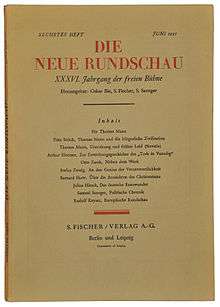Disorder and Early Sorrow
 First published in Die neue Rundschau | |
| Author | Thomas Mann |
|---|---|
| Original title | Unordnung und frühes Leid |
| Country | Germany |
| Language | German |
| Genre | Novella |
| Publisher | S. Fischer Verlag |
Publication date |
1925 (periodical) 1926 (book) |
Disorder and Early Sorrow (German: Unordnung und frühes Leid) is a 1925 novella written by Thomas Mann. It follows the fortunes of the Cornelius family through the perspective of Abel Cornelius (written in a third person narrative voice), a 47-year-old professor at the local university, whose status in society was once highly respected but has diminished markedly. The Cornelius family is, in part, a reflection of Mann's own family. The novella explores the psychological and social impact of the Weimar Hyperinflation. It first appeared in a Festschrift celebrating Mann's 50th birthday in the publication Neue Rundschau.[1]
Plot summary
The novella is set in one day in Munich in Weimar Germany. The Cornelius family are preparing a party for Ingrid and Bert, Professor Cornelius's children. The family are divided up on the basis of chronology, foreshadowing one of the central themes of the work which is the interplay between different generations at a time of dislocating social and economic change. Ingrid and Bert, both adolescents, are "the big folk"; Professor Cornelius and his wife are "the old folk"; Ellie and Snapper, their youngest children, are "the little folk"; and Professor Cornelius’s parents, who are only discussed and who do not feature directly in the story, are categorised as "the ancients".[2]
Film version
A West German film adaptation directed by Franz Seitz, Jr. was released in 1977, also titled Unordnung und frühes Leid.[3]
References
- ↑ "Introduction & Overview of Disorder and Early Sorrow by Thomas Mann". Bookrags. Retrieved 28 June 2014.
- ↑ "Disorder and Early Sorrow". Encyclopedia.com. Retrieved 28 June 2014.
- ↑ "Unordnung und Fruehes Leid (1977)". AllMovie. Retrieved 28 June 2014.